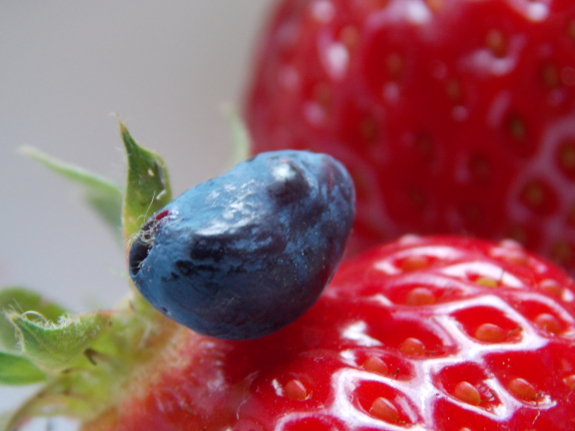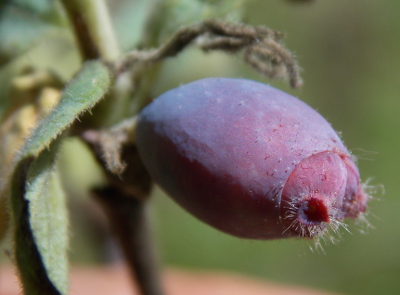
Testing out honeyberries

We planted two honeyberry
bushes last spring (Blue Sea and Blue Velvet), and a few berries showed
up on each last month. I waited with baited breath as the first
one turned pink and then purple, then I waited yet a little longer since
I've heard that honeyberries are best when eaten very ripe. At
long last, it was time for a taste test.
The conclusion?
Half of a tiny honeyberry is too small of a morsel to register on your
tastebuds. Drat! I guess I'll have to wait until next year
for a real flavor sampling. In the meantime, though, I can write
about how honeyberries live up to other claims by nurseries and by
garden writers.
 The
main reason I planted honeyberries is because I'd read that the fruits
ripen up before strawberries in the spring. This appears to be
false on our farm --- we ate our first strawberries a few days before
our honeyberry. On the other hand, our honeyberry bushes are
planted closer to the hillside, meaning the ground there is colder in
the spring and the plants might grow more slowly than they would have if
planted in a more sunny location. If a taste test next year
suggest the species is worth committing to, I'll try out some more
bushes in a warmer spot --- honeyberries are just rebranded honeysuckles
(Lonicera caerulea), so they should be easy to propagate
The
main reason I planted honeyberries is because I'd read that the fruits
ripen up before strawberries in the spring. This appears to be
false on our farm --- we ate our first strawberries a few days before
our honeyberry. On the other hand, our honeyberry bushes are
planted closer to the hillside, meaning the ground there is colder in
the spring and the plants might grow more slowly than they would have if
planted in a more sunny location. If a taste test next year
suggest the species is worth committing to, I'll try out some more
bushes in a warmer spot --- honeyberries are just rebranded honeysuckles
(Lonicera caerulea), so they should be easy to propagate
Honeyberries did better
in the second claim department --- that they grow well in shade.
The area where our bushes are growing is on the shady side
of our blueberry patch, so they get about six hours of shade at the
summer solstice. Despite the lack of sun, the bushes are doing
great and are fruiting already (albeit lightly), so the species
definitely does fit into those difficult-to-harvest-from shady areas.
I'd be curious to hear
from others who have eaten more than half of a honeyberry. What do
you think of the flavor? And do honeyberries ripen up before
strawberries in your neck of the woods?
Want more in-depth information? Browse through our books.
Or explore more posts by date or by subject.
About us: Anna Hess and Mark Hamilton spent over a decade living self-sufficiently in the mountains of Virginia before moving north to start over from scratch in the foothills of Ohio. They've experimented with permaculture, no-till gardening, trailersteading, home-based microbusinesses and much more, writing about their adventures in both blogs and books.
Want to be notified when new comments are posted on this page? Click on the RSS button after you add a comment to subscribe to the comment feed, or simply check the box beside "email replies to me" while writing your comment.

I love this post. I can see this starting a huge rush for honeyberries among homesteaders just in case there are regions where they come first. Are there other varieties that come earlier, before strawberries?
Personally I am new to currants. Kinda. I think Mom always loved them, but I think the one bush I ever knew of went down her throat before I got to them! I do know that the bush we currently have has red fruit on it now.
Maybe you already have currants. If that is not a good suggestion, maybe think about different varieties like varieties that come sooner!
I'm in zone 3 and grow 3 different species of honeyberry... all of which are zone 2/3 hardy. So its definitely possible that there'll be some variation in flavor... however... at 90% ripe, they're tart... so if you like tart you'll like these. If you wait until they're bordering on overripe, they'll actually fill with enough sugar to mitigate the tartness... they become a bit like sour sweet candies.
Two points to add to this:
1) These things are amazingly hardy and vigorous. I planted several bushes in hard clay which was light on fertiility giving them only a mulch to move forward with. And... they grew quickly and produced hard. Very impressive.
2) Up here in zone 3, they put out ripe berries 2-4 weeks before the first strawberries come in.
Or you have strawberries that ripen pretty early in your climate.
Up here though... my honeyberry bushes literally start budding 1 week after the snow goes. They're the first to bud, leaf, flower, and fruit (which is great as it get bees onto my acreage very early in the year). I'm betting the cold hardiness factor of these has much to do with their timeline.